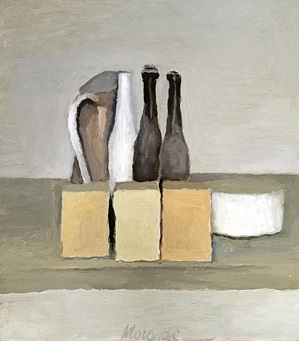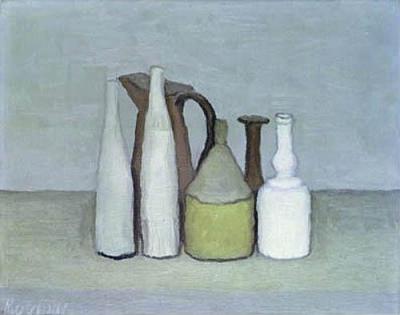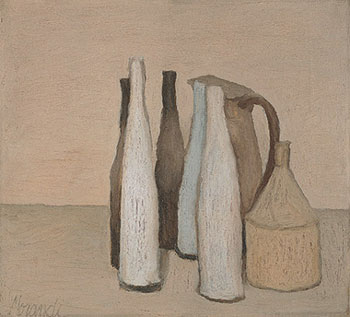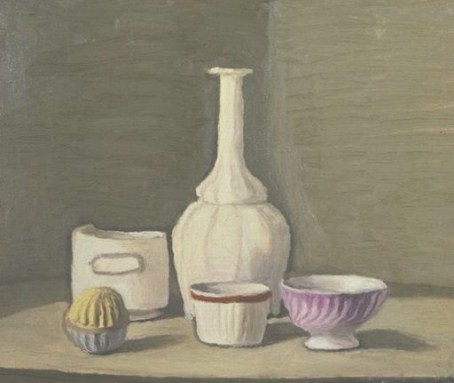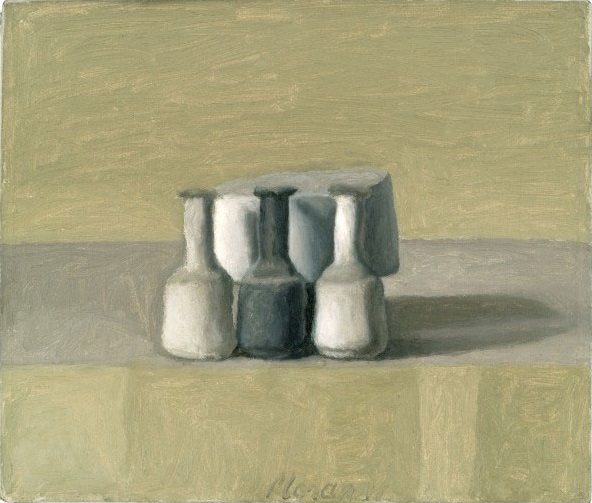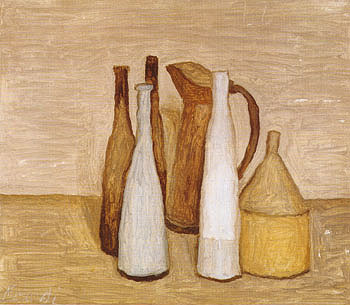<Back to Index>
- Painter Giorgio Morandi, 1890
PAGE SPONSOR
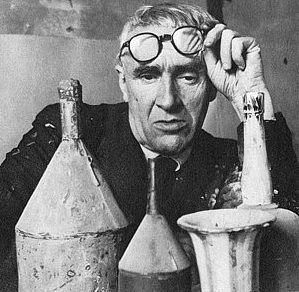
Giorgio Morandi (July 20, 1890 – June 18, 1964) was an Italian painter and printmaker who specialized in still life. His paintings are noted for their tonal subtlety in depicting apparently simple subjects, which were limited mainly to vases, bottles, bowls, flowers and landscapes.
Giorgio Morandi was born in Bologna to Andrea and Maria Maccaferri. Little Giorgio lived first on via Lame where his brother Giuseppe (who died in 1903) and his sister Anna were born. The family then moved to via Avesella n. 30, where his two other sisters were born, Dina in 1900 and Maria Teresa in 1906. From 1907 to 1913 he studied at the Accademia di Belle Arti of Bologna. After the death of his father in 1909, the family moved to via Fondazza n. 36, and Morandi became the head of the family.
At the Accademia, which based its traditions on 14th century painting, Morandi taught himself to etch by studying books on Rembrandt. He was excellent at his studies, although his professors disapproved of the changes in his style during his final two years at the Accademia. Morandi, even if he lived his whole life in Bologna, was influenced by the works of Cézanne, Derain and Picasso. However, in particular after a trip to Florence in 1910, he was also influenced by past artists such as Giotto, Masaccio, Piero Della Francesca and Paolo Uccello. He also had a brief digression into a Futurist style in 1914. In that same year, Morandi was appointed instructor of drawing for elementary schools in Bologna — a post he held until 1929.
In 1915, he joined the army but suffered a breakdown and was indefinitely discharged. During the war, Morandi's still lifes became more reduced in their compositional elements and purer in form, revealing his admiration for both Cézanne and the Douanier Rousseau.
The Metaphysical painting (Pittura Metafisica) phase in Morandi's work lasted from 1918 to 1922. This was to be his last major stylistic shift; thereafter, he focused increasingly on subtle gradations of hue, tone, and objects arranged in a unifying atmospheric haze, establishing the direction his art was to take for the rest of his life. Morandi showed in the Novecento Italiano exhibitions of 1926 and 1929, but was more specifically associated with the regional Strapaese group by the end of the decade, a fascist influenced group emphasizing local cultural traditions. He was sympathetic to the Fascist party in the 1920s, although his friendships with anti - Fascist figures led authorities to arrest him briefly in 1943. From 1928 Morandi participated in some of the Venice Biennale exhibitions, in the Quadriennale in Rome and also exhibited in different Italian and foreign cities.
In 1929 Giorgio Morandi illustrated the work Il sole a picco by Vincenzo Cardarelli, winner of the Premio Bagutta. From 1930 to 1956, Morandi was a professor of etching at Accademia di Belle Arti. The 1948 Venice Biennale awarded him first prize for painting, he visited Paris for the first time in 1956, and in 1957 he won the grand prize in São Paulo's Biennial.
Quiet, polite both in his private and public life, Morandi was much
talked about in Bologna for his enigmatic yet very optimistic
personality. Morandi lived on via Fondazza, in Bologna, with his three
sisters Anna, Dina and Maria Teresa, until his death on June 18, 1964.
Throughout his career, Morandi concentrated almost exclusively on still lifes and landscapes, except for a few self portraits. With great sensitivity to tone, color, and compositional balance, he would depict the same familiar bottles and vases again and again in paintings notable for their simplicity of execution. A prolific painter, he completed some 1350 oil paintings. He also executed 133 etchings, a significant body of work in its own right, and his drawings and watercolors often approach abstraction in their economy of means. He explained: "What interests me most is expressing what’s in nature, in the visible world, that is"; he also said, "Nothing is more abstract than reality".
Morandi was perceived as one of the few Italian artists of his generation to have escaped the taint of Fascism, and to have evolved a style of pure pictorial values congenial to modernist abstraction. Through his simple and repetitive motifs and economical use of color, value and surface, Morandi became a prescient and important forerunner of Minimalism.
Morandi is buried at Certosa cemetery in Bologna in the family tomb together with his three sisters. On his tomb there is a portrait of him donated by his friend Giacomo Manzu. In 1992, Palazzo D'Accursio in Bologna created the Giorgio Morandi museum, thanks to the donation made by his sister Maria Teresa Morandi of his works and also the atelier of the artist which were family belongings.
He has been written about by Philippe Jaccottet, Jean Leymarie, Jean Clair, Yves Bonnefoy, Roberto Longhi, Francesco Arcangeli, Cesare Brandi, Lambeto Vitali, Luigi Magnani, Marilena Pasquali and many other critics.
Federico Fellini paid tribute to him in his film La Dolce Vita, which featured Morandi's paintings, as does La notte by Michelangelo Antonioni. One of the main characters in Sarah Hall's novel How to Paint a Dead Man is loosely based on Morandi. Don DeLillo's 9/11 novel "Falling Man" (2007) includes two Morandi still life paintings on the wall of Nina's New York apartment. Morandi was a particular favorite of eccentric Scottish poet Ivor Cutler, who included a poem about the painter in his 1973 anthology Many Flies Have Feathers.
Two oil paintings by Morandi were chosen by the President of the United States Barack Obama in 2009 and are now part of the White House collection.
Today, there is a museum dedicated to the display of Morandi's work, including a reconstruction of his studio, in Bologna.
Although Morandi was not greatly concerned with exhibitions during his
own lifetime, his works have been displayed in the Modern Art Museum of
Bologna and in many other cities, due largely to the Centro Studi
Giorgio Morandi. In December 2008 an exhibition was dedicated to Giorgio
Morandi at the Metropolitan Museum of Art in New York.
Some of the most famous photographers of the 20th century took Morandi's photo at his house on via Fondazza, at Grizzana Morandi's house, and at the Venice Biennale. Among the photographers who took Giorgio Morandi's picture or pictures of his studio are: Herbert List, Duane Michals, Jean Francois Bauret, Paolo Prandi, Paolo Ferrari, Lamberto Vitali, Libero Grandi, Franz Hubmann, Leo Lionni, Antonio Masotti, Carlo Ludovico Ragghianti, Lee Miller, Giancolombo, Ugo Mulas, Luigi Ghirri, Gianni Berengo Gardin, and Luciano Calzolari.
The film maker Tacita Dean filmed the inside of this artist's house on Fondazza.
